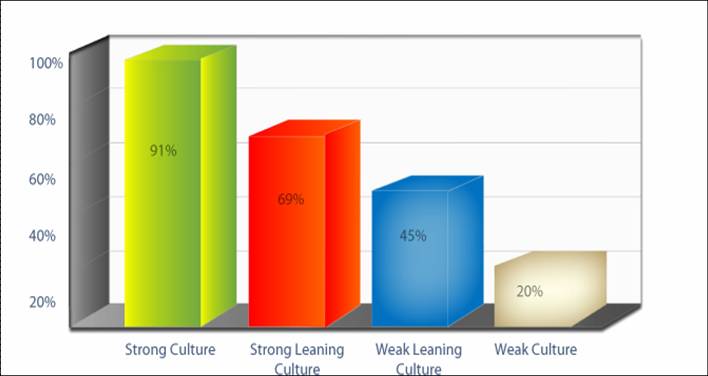|
|
|
Tuesday, January 12th, 2010
 Great Place To Work just released their Best Places to Work rankings for large, medium and small companies in countries around the world. So out of the thousands of companies how are the best places to work chosen? Great Place To Work just released their Best Places to Work rankings for large, medium and small companies in countries around the world. So out of the thousands of companies how are the best places to work chosen?
Our approach is based on the major findings of 20 years of research – that trust between managers and employees is the primary defining characteristic of the very best workplaces.
At the heart of our definition of a great place to work – a place where employees “trust the people they work for, have pride in what they do, and enjoy the people they work with” – is the idea that a great workplace is measured by the quality of the three, interconnected relationships that exist there:
- The relationship between employees and management.
- The relationship between employees and their jobs/company.
- The relationship between employees and other employees.
In other words, it all comes down to trust and culture.
The funny thing about trust and culture is that the managers at all levels who strive to build trust and work create great, fun, inclusive cultures are reading this and nodding their heads, while those that don’t are clicking off to another site, because all the proof in the world won’t change their minds.
Proof is found in places such as the Ethics Resource Center’s the January 6th article Top Executives – Overpaid or Underappreciated? A whopping 91% have no problem with executive compensation when there is a strong, fair culture in place. (Hat tip to Lauren Bloom for pointing me to this site.)

Imagine the level of idiocy required to blind people to studies such as this.
The North American winners in each category may surprise you—they certainly surprised me.
- NetApp is the #1 large company;
- Ultimate Software is the #1 medium company; and
- Badger Mining Corporation is the #1 small company.
Ever wonder which companies are at the other end of the spectrum? The companies where the culture ranges from suspect to toxic and executive compensation outrages both employees and the rest of us?
I found the answer to that at 24/7 Wall St’s The 15 Most Hated Companies In America.
Can you guess which company has the dubious distinction of the #1 position?
Think; what company violated trust in every way possible and is know for it’s culture of ego, hubris, and obscene bonuses?
Right. The most hated company in America is AIG.
The upside of all these studies is that those trying to do it right have examples to emulate and kudos for their accomplishments.
The downside is that the others wouldn’t notice if you hit them on the head—AIG certainly hasn’t.
Image credit: Ethics Resource Center
Posted in Business info, Culture, Ducks In A Row, Leadership, Retention | 2 Comments »
Tuesday, November 10th, 2009
 What do you think about slogans? Do they resonate with you or do you just shrug them off? What do you think about slogans? Do they resonate with you or do you just shrug them off?
The subject came up when a client asked me whether it was worth the effort of finding an effective slogan for a new program at his company; he said the idea surfaced because of the success of President Obama’s “Yes we can” during the last election.
Our conversation reminded me of an article last year about the futility of slogans in today’s world by Dan and Chip Heath, co-authors of Made to Stick.
Now, Made to Stick has some great stuff in it and they made some good points, but overall I don’t agree that snappy slogans have no value.
There’s a reason that slogans have been around since 1500’s and that’s because human beings respond to them. They started as battle cries that roused the troops and gave them something to scream when going into battle; something that in a few short words told the world who they were and what they believed.
The Heaths think that has changed.
“People don’t speak slogan-language today unless they’re trying to put one over on you. So when you hear one, you immediately become cynical.”
They say this in spite of the fact that the first thing all the groups they described did, corporate and non-profit alike, was to find a slogan that encapsulated their goals.
The problem comes if the slogan is all there is; the Heaths used this example to prove their point, whereas I think it proves mine.
“Recently, a task force of top execs at a large technology company was brainstorming about a new leadership initiative. It wanted the company’s managers to spend more time developing their people and less on giving orders. To make this happen, the firm would have to change the way those managers were groomed, paid, and evaluated. Yet, facing these epic changes, the task force felt the need to hammer out a slogan. It was a doozy (mildly disguised for confidentiality): “360-Degree Leadership: Because we all matter.” Just then, all the employees in the universe rolled their eyes.”
I’ve seen many similar slogans that deserved the eye rolls, but this one doesn’t.
If all the execs had done was to announce the slogan and tell the company’s managers that they needed to put more effort into developing their people, then the slogan would be cheap, feel-good talk and I would agree with the cynicism—but they didn’t.
The key to the difference lies in these words, “the firm would have to change the way those managers were groomed, paid, and evaluated.”
Assuming that the company followed through with the changes and educated its managers to their new responsibilities, then the slogan has teeth and it becomes a war cry that can rally the troops.
The stories the Heaths recommend are great; use them to explain; use real examples to show the words in action, but as good as they are for communication, you can’t scream them when going into battle.
Slogans can inspire and encourage; they can tell a story to the world in just a few words; the good ones can be a lifeline when there is nothing else to grab.
People like slogans, even Millennials; what they don’t like are feel-good words and empty promises wrapped up in a snappy package.
Your comments—priceless
Don’t miss a post, subscribe via RSS or EMAIL
Image credit: ZedBee|Zoë Power on flickr
Posted in About Business, Communication, Culture, Ducks In A Row | No Comments »
Wednesday, September 30th, 2009

(Read yesterday’s post if you don’t understand.)
Click to learn about the result of good management
Your comments—priceless
Don’t miss a post, subscribe via RSS or EMAIL
Image credit: blmurch on flickr
Posted in Culture, Wordless Wednesday | No Comments »
Tuesday, September 29th, 2009
 Company culture is a hot topic in the business press; CEOs are working to foster “cultures of innovation;” and culture is being lauded or blamed for a variety of happenings. Company culture is a hot topic in the business press; CEOs are working to foster “cultures of innovation;” and culture is being lauded or blamed for a variety of happenings.
The bird’s eye view of what’s important in culture is as varied as the executives, academics, pundits, media and other experts who expound on the subject.
But what about the worm’s eye view—what do plain vanilla employees think and want? It’s important, since without them there is no company.
It used to be when I talked with people that it was easier for them to articulate the attitudes and behaviors they didn’t want to encounter in the workplace.
Even today, with a far more savvy and sophisticated workforce, people still tend to focus first on what they don’t want:
- Too much politics: personal, group, or in senior management.
- Unnecessary bureaucracy.
- Poor management practices such as erratic management; intimidation; micro-management; belittling or contemptuous treatment; poor scheduling; no loyalty; the attitude that “we don’t have enough time to do it right but we have enough time to do it over;” workaholism; etc.
- Any form of harassment, whether overt or covert
- A generally negative attitude, i.e., the glass is half empty
- Arrogance or an elitist attitude.
- An unwillingness (at whatever level) to seek and implement the compromises necessary to meet most of the organization’s needs within the required timeframe.
But when you get them to focus on the positives, the sophisticated and savvier mindset of today’s workforce is even more obvious when discussing the factors they desire.
Here are some of the high points that people say they want for themselves and from their managers and company:
- The opportunity to truly “make a difference.”
- To be treated fairly.
- To trust the management and be trusted by them.
- To embrace the idea that work can and should be fun.
- Accurate prioritizing of company, team, and individual goals while keeping them synergistic.
- A positive “can-do” attitude (aggressive, but realistic—the glass is half-full).
- Continuing development and quality improvement in people, products and services, and processes.
- Committing to employees, customers, and investors—and meeting those commitments.
- An open, accurate, company-wide flow of information starting from the top.
- An environment that encourages people to reach their full potential, professionally and personally.
- A conscious effort to stamp out “not invented here” syndrome (in all its varied forms) so as to not waste time reinventing the wheel.
There’s great value in this worm’s eye view. By eliminating what employees don’t like, and giving them what they want, you create a foundation on which to build the kind of innovative, profitable culture—the kind craved by investors, customers, and the rest of the outside world.
Your comments—priceless
Don’t miss a post, subscribe via RSS or EMAIL
Image credit: ZedBee|Zoë Power on flickr
Posted in About Leadership, Culture, Innovation, What Leaders DO | 1 Comment »
Wednesday, September 2nd, 2009

Now take a look at the perfect vacation
Your comments—priceless
Don’t miss a post, subscribe via RSS or EMAIL
Image credit: maurice.heuts on flickr
Posted in Culture, management, Wordless Wednesday | No Comments »
Monday, August 31st, 2009
Did you do your homework from Saturday?
I asked you to read Heather Clancy’s take on great culture and said that I’d explain today why I disagree.
 The problem I have is with the idea of culture as a cult. The problem I have is with the idea of culture as a cult.
The definition of cult is given as “great devotion to a person, idea, object, movement, or work,” and culture as “set of shared attitudes, values, goals, and practices;” Heather sees ‘devotion’ and ‘shared’ as interchangeable—and that makes me very uncomfortable.
Another definition for cult is “obsessive, especially faddish, devotion to or veneration for a person, principle, or thing.”
The examples she uses, Apple, Google and Salesforce.com, are superb companies.
But when someone says ‘cult’ to me I think of Jim Jones, whose followers had great devotion, so much that they followed Jones to the death—literally.
Lehman Brothers and other Wall Street banking houses had/have strong cult cultures as does AIG. Their people had great devotion and passion to cultures that were focused on winning no matter what and we all know where that got us. Another enterprise that comes to mind is Enron.
The point I’m making is that cult culture, like most concepts, cuts both ways.
When culture becomes a cult it can lose its flexibility and willingness to grow and change—necessities in today’s fast-changing world.
It’s always tempting to choose examples that highlight the positive view of a business (or any) concept, but it is imperative to avoid assumptions and remember that there are two sides to everything.
Image credit: Gúnna on flickr
Posted in Business info, Communication, Culture | 1 Comment »
Sunday, August 30th, 2009
See all mY generation posts here.

Posted in Culture, mY generation | No Comments »
Wednesday, August 19th, 2009

Now check out this great cultural goal
Your comments—priceless
Don’t miss a post, subscribe via RSS or EMAIL
Image credit: WILPF
Posted in Ethics, Wordless Wednesday | No Comments »
Sunday, August 9th, 2009
See all mY generation posts here.

Posted in Business info, Culture, Motivation, mY generation, Retention | No Comments »
|
 Subscribe to
Subscribe to
MAPping Company Success
About Miki 
Clarify your exec summary, website, etc.
Have a quick question or just want to chat? Feel free to write or call me at 360.335.8054
The 12 Ingredients of a Fillable Req
CheatSheet for InterviewERS
CheatSheet for InterviewEEs™
Give your mind a rest. Here are 4 quick ways to get rid of kinks, break a logjam or juice your creativity!
Creative mousing
Bubblewrap!
Animal innovation
Brain teaser
The latest disaster is here at home; donate to the East Coast recovery efforts now!
Text REDCROSS to 90999 to make a $10 donation or call 00.733.2767. $10 really really does make a difference and you'll never miss it.
And always donate what you can whenever you can
The following accept cash and in-kind donations: Doctors Without Borders, UNICEF, Red Cross, World Food Program, Save the Children
*/
?>About Miki
About KG
Clarify your exec summary, website, marketing collateral, etc.
Have a question or just want to chat @ no cost? Feel free to write
Download useful assistance now.
Entrepreneurs face difficulties that are hard for most people to imagine, let alone understand. You can find anonymous help and connections that do understand at 7 cups of tea.
Crises never end.
$10 really does make a difference and you’ll never miss it,
while $10 a month has exponential power.
Always donate what you can whenever you can.
The following accept cash and in-kind donations:
|
 Great Place To Work just released their Best Places to Work rankings for large, medium and small companies in countries around the world. So out of the thousands of companies how are the best places to work chosen?
Great Place To Work just released their Best Places to Work rankings for large, medium and small companies in countries around the world. So out of the thousands of companies how are the best places to work chosen?




 What do you think about slogans? Do they resonate with you or do you just shrug them off?
What do you think about slogans? Do they resonate with you or do you just shrug them off?

 The problem I have is with the idea of culture as a cult.
The problem I have is with the idea of culture as a cult.




